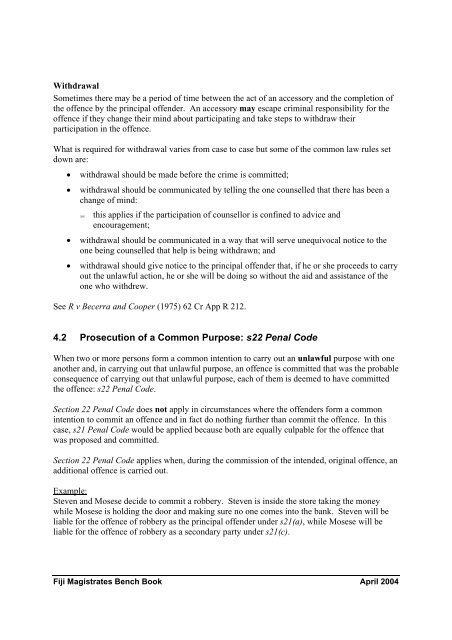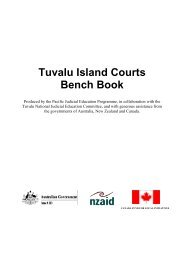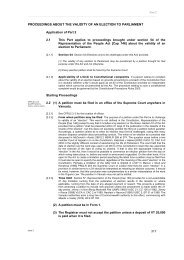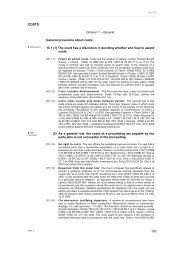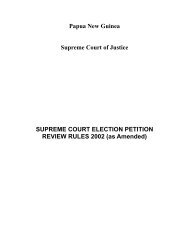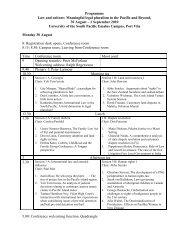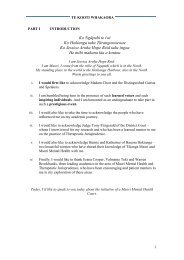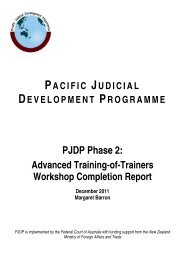Fiji Magistrates Bench Book - Federal Court of Australia
Fiji Magistrates Bench Book - Federal Court of Australia
Fiji Magistrates Bench Book - Federal Court of Australia
You also want an ePaper? Increase the reach of your titles
YUMPU automatically turns print PDFs into web optimized ePapers that Google loves.
Withdrawal<br />
Sometimes there may be a period <strong>of</strong> time between the act <strong>of</strong> an accessory and the completion <strong>of</strong><br />
the <strong>of</strong>fence by the principal <strong>of</strong>fender. An accessory may escape criminal responsibility for the<br />
<strong>of</strong>fence if they change their mind about participating and take steps to withdraw their<br />
participation in the <strong>of</strong>fence.<br />
What is required for withdrawal varies from case to case but some <strong>of</strong> the common law rules set<br />
down are:<br />
• withdrawal should be made before the crime is committed;<br />
• withdrawal should be communicated by telling the one counselled that there has been a<br />
change <strong>of</strong> mind:<br />
this applies if the participation <strong>of</strong> counsellor is confined to advice and<br />
encouragement;<br />
• withdrawal should be communicated in a way that will serve unequivocal notice to the<br />
one being counselled that help is being withdrawn; and<br />
• withdrawal should give notice to the principal <strong>of</strong>fender that, if he or she proceeds to carry<br />
out the unlawful action, he or she will be doing so without the aid and assistance <strong>of</strong> the<br />
one who withdrew.<br />
See R v Becerra and Cooper (1975) 62 Cr App R 212.<br />
4.2 Prosecution <strong>of</strong> a Common Purpose: s22 Penal Code<br />
When two or more persons form a common intention to carry out an unlawful purpose with one<br />
another and, in carrying out that unlawful purpose, an <strong>of</strong>fence is committed that was the probable<br />
consequence <strong>of</strong> carrying out that unlawful purpose, each <strong>of</strong> them is deemed to have committed<br />
the <strong>of</strong>fence: s22 Penal Code.<br />
Section 22 Penal Code does not apply in circumstances where the <strong>of</strong>fenders form a common<br />
intention to commit an <strong>of</strong>fence and in fact do nothing further than commit the <strong>of</strong>fence. In this<br />
case, s21 Penal Code would be applied because both are equally culpable for the <strong>of</strong>fence that<br />
was proposed and committed.<br />
Section 22 Penal Code applies when, during the commission <strong>of</strong> the intended, original <strong>of</strong>fence, an<br />
additional <strong>of</strong>fence is carried out.<br />
Example:<br />
Steven and Mosese decide to commit a robbery. Steven is inside the store taking the money<br />
while Mosese is holding the door and making sure no one comes into the bank. Steven will be<br />
liable for the <strong>of</strong>fence <strong>of</strong> robbery as the principal <strong>of</strong>fender under s21(a), while Mosese will be<br />
liable for the <strong>of</strong>fence <strong>of</strong> robbery as a secondary party under s21(c).<br />
<strong>Fiji</strong> <strong>Magistrates</strong> <strong>Bench</strong> <strong>Book</strong> April 2004


